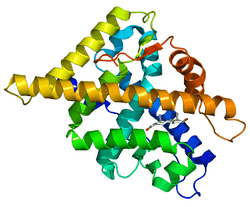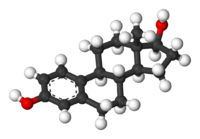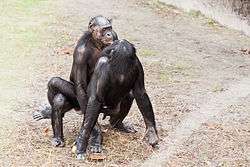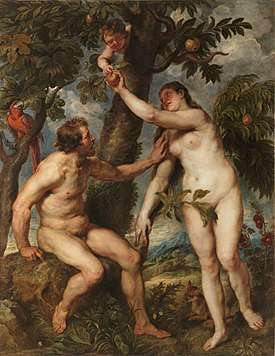Heterosexuality
Heterosexuality is romantic attraction, sexual attraction or sexual behavior between persons of the opposite sex or gender. As a sexual orientation, heterosexuality is "an enduring pattern of emotional, romantic, and/or sexual attractions" to persons of the opposite sex; it "also refers to a person's sense of identity based on those attractions, related behaviors, and membership in a community of others who share those attractions."[1][2] Someone who is heterosexual is commonly referred to as straight.
| Sexual orientation |
|---|
| Sexual orientations |
| Non-binary categories |
| Research |
| Non-human animals |
| Related topics |
|
Along with bisexuality and homosexuality, heterosexuality is one of the three main categories of sexual orientation within the heterosexual–homosexual continuum.[1] Across cultures, most people are heterosexual, and heterosexual activity is by far the most common type of sexual activity.[3][4]
Scientists do not know the exact cause of sexual orientation, but they theorize that it is caused by a complex interplay of genetic, hormonal, and environmental influences,[5][6][7] and do not view it as a choice.[5][6][8] Although no single theory on the cause of sexual orientation has yet gained widespread support, scientists favor biologically-based theories.[5] There is considerably more evidence supporting nonsocial, biological causes of sexual orientation than social ones, especially for males.[3][9][10]
The term heterosexual or heterosexuality is usually applied to humans, but heterosexual behavior is observed in all other mammals and in other animals, as it is necessary for sexual reproduction.
Terminology
Hetero- comes from the Greek word ἕτερος [héteros], meaning "other party" or "another",[11] used in science as a prefix meaning "different";[12] and the Latin word for sex (that is, characteristic sex or sexual differentiation).
The current use of the term heterosexual has its roots in the broader 19th century tradition of personality taxonomy. The term heterosexual was coined alongside the word homosexual by Karl Maria Kertbeny in 1869.[13] The terms were not in current use during the late nineteenth century, but were reintroduced by Richard von Krafft-Ebing and Albert Moll around 1890.[13] The noun came into wider use from the early 1920s, but did not enter common use until the 1960s. The colloquial shortening "hetero" is attested from 1933. The abstract noun "heterosexuality" is first recorded in 1900.[14] The word "heterosexual" was listed in Merriam-Webster's New International Dictionary in 1923 as a medical term for "morbid sexual passion for one of the opposite sex"; however, in 1934 in their Second Edition Unabridged it is defined as a "manifestation of sexual passion for one of the opposite sex; normal sexuality".[15]
In LGBT slang, the term breeder has been used as a denigrating phrase to deride heterosexuals. Hyponyms of heterosexual include heteroflexible.[16][17]
The word can be informally[18] shortened to "hetero".[19] The term straight originated as a mid-20th century gay slang term for heterosexuals, ultimately coming from the phrase "to go straight" (as in "straight and narrow"), or stop engaging in homosexual sex. One of the first uses of the word in this way was in 1941 by author G. W. Henry.[20] Henry's book concerned conversations with homosexual males and used this term in connection with people who are identified as ex-gays. It is now simply a colloquial term for "heterosexual", having changed in primary meaning over time. Some object to usage of the term straight because it implies that non-heteros are crooked.[21]
Demographics
In their 2016 literature review, Bailey et al. stated that they "expect that in all cultures the vast majority of individuals are sexually predisposed exclusively to the other sex (i.e., heterosexual)" and that there is no persuasive evidence that the demographics of sexual orientation have varied much across time or place.[3] Heterosexual activity between only one male and one female is by far the most common type of sociosexual activity.[4]
According to several major studies, 89% to 98% of people have had only heterosexual contact within their lifetime;[22][23][24][25] but this percentage falls to 79–84% when either or both same-sex attraction and behavior are reported.[25]
A 1992 study reported that 93.9% of males in Britain have only had heterosexual experience, while in France the number was reported at 95.9%.[26] According to a 2008 poll, 85% of Britons have only opposite-sex sexual contact while 94% of Britons identify themselves as heterosexual.[27] Similarly, a survey by the UK Office for National Statistics (ONS) in 2010 found that 95% of Britons identified as heterosexual, 1.5% of Britons identified themselves as homosexual or bisexual, and the last 3.5% gave more vague answers such as "don't know", "other", or did not respond to the question.[28][29] In the United States, according to a Williams Institute report in April 2011, 96% or approximately 250 million of the adult population are heterosexual.[30][31]
An October 2012 Gallup poll provided unprecedented demographic information about those who identify as heterosexual, arriving at the conclusion that 96.6%, with a margin of error of ±1%, of all U.S. adults identify as heterosexual.[32] The Gallup results show:
| Age/Gender | Heterosexual | Non-heterosexual | Don't know/Refused |
|---|---|---|---|
| 18–29 | 90.1% | 6.4% | 3.5% |
| 30–49 | 93.6% | 3.2% | 3.2% |
| 50–64 | 93.1% | 2.6% | 4.3% |
| 65+ | 91.5% | 1.9% | 6.5% |
| 18–29, Women | 88.0% | 8.3% | 3.8% |
| 18–29, Men | 92.1% | 4.6% | 3.3% |
In a 2015 YouGov survey of 1,000 adults of the United States, 89% of the sample identified as heterosexual, 4% as homosexual (2% as homosexual male and 2% as homosexual female) and 4% as bisexual (of either sex).[33]
Bailey et al., in their 2016 review, stated that in recent Western surveys, about 93% of men and 87% of women identify as completely heterosexual, and about 4% of men and 10% of women as mostly heterosexual.[3]
Academic study
Biological and environmental
No simple and singular determinant for sexual orientation has been conclusively demonstrated, but scientists believe that a combination of genetic, hormonal, and environmental factors determine sexual orientation.[5][6][7] They favor biological theories for explaining the causes of sexual orientation,[3][5] as there is considerably more evidence supporting nonsocial, biological causes than social ones, especially for males.[3][9][10]
Factors related to the development of a heterosexual orientation include genes, prenatal hormones, and brain structure, and their interaction with the environment.
Prenatal hormones



The neurobiology of the masculinization of the brain is fairly well understood. Estradiol and testosterone, which is catalyzed by the enzyme 5α-reductase into dihydrotestosterone, act upon androgen receptors in the brain to masculinize it. If there are few androgen receptors (people with androgen insensitivity syndrome) or too much androgen (females with congenital adrenal hyperplasia), there can be physical and psychological effects.[35] It has been suggested that both male and female heterosexuality are the results of this process.[36] In these studies heterosexuality in females is linked to a lower amount of masculinization than is found in lesbian females, though when dealing with male heterosexuality there are results supporting both higher and lower degrees of masculinization than homosexual males.
Animals and reproduction


Sexual reproduction in the animal world is facilitated through opposite-sex sexual activity, although there are also animals that reproduce asexually, including protozoa and lower invertebrates.[37]
Reproductive sex does not require a heterosexual orientation, since sexual orientation typically refers to a long-term enduring pattern of sexual and emotional attraction leading often to long-term social bonding, while reproduction requires as little as a single act of copulation to fertilize the ovum by sperm.[38][39][40]
Sexual fluidity
Often, sexual orientation and sexual orientation identity are not distinguished, which can impact accurately assessing sexual identity and whether or not sexual orientation is able to change; sexual orientation identity can change throughout an individual's life, and may or may not align with biological sex, sexual behavior or actual sexual orientation.[41][42][43] Sexual orientation is stable and unlikely to change for the vast majority of people, but some research indicates that some people may experience change in their sexual orientation, and this is more likely for women than for men.[44] The American Psychological Association distinguishes between sexual orientation (an innate attraction) and sexual orientation identity (which may change at any point in a person's life).[45]
A 2012 study found that 2% of a sample of 2,560 adult participants reported a change of sexual orientation identity after a 10-year period. For men, a change occurred in 0.78% of those who had identified as heterosexual, 9.52% of homosexuals, and 47% of bisexuals. For women, a change occurred in 1.36% of heterosexuals, 63.6% of lesbians, and 64.7% of bisexuals.[46]
A 2-year study by Lisa M. Diamond on a sample of 80 non-heterosexual female adolescents (age 16-23) reported that half of the participants had changed sexual-minority identities more than once, one third of them during the 2-year follow-up. Diamond concluded that "although sexual attractions appear fairly stable, sexual identities and behaviors are more fluid."[47]
Heteroflexibility is a form of sexual orientation or situational sexual behavior characterized by minimal homosexual activity in an otherwise primarily heterosexual orientation that is considered to distinguish it from bisexuality. It has been characterized as "mostly straight".[48]
Sexual orientation change efforts
Sexual orientation change efforts are methods that aim to change sexual orientation, used to try to convert homosexual and bisexual people to heterosexuality. Scientists and mental health professionals generally do not believe that sexual orientation is a choice.[5][8] There are no studies of adequate scientific rigor that conclude that sexual orientation change efforts are effective.[49]
Society and culture

A heterosexual couple, a man and woman in an intimate relationship, form the core of a nuclear family.[50] Many societies throughout history have insisted that a marriage take place before the couple settle down, but enforcement of this rule or compliance with it has varied considerably.
Symbolism

Heterosexual symbolism dates back to the earliest artifacts of humanity, with gender symbols, ritual fertility carvings, and primitive art. This was later expressed in the symbolism of fertility rites and polytheistic worship, which often included images of human reproductive organs, such as lingam in Hinduism. Modern symbols of heterosexuality in societies derived from European traditions still reference symbols used in these ancient beliefs. One such image is a combination of the symbol for Mars, the Roman god of war, as the definitive male symbol of masculinity, and Venus, the Roman goddess of love and beauty, as the definitive female symbol of femininity. The unicode character for this combined symbol is ⚤ (U+26A4).
Historical views
There was no need to coin a term such as heterosexual until there was something else to contrast and compare it with. Jonathan Ned Katz dates the definition of heterosexuality, as it is used today, to the late 19th century.[51] According to Katz, in the Victorian era, sex was seen as a means to achieve reproduction, and relations between the sexes were not believed to be overtly sexual. The body was thought of as a tool for procreation, "human energy, though of as a closed and severely limited system, was to be used in producing children and in work, not wasted in libidinous pleasures."[51]
Katz argues that modern ideas of sexuality and eroticism began to develop in America and Germany in the later 19th century. The changing economy and the "transformation of the family from producer to consumer"[51] resulted in shifting values. The Victorian work ethic had changed, pleasure became more highly valued and this allowed ideas of human sexuality to change. Consumer culture had created a market for the erotic, pleasure became commoditized. At the same time medical doctors began to acquire more power and influence. They developed the medical model of "normal love," in which healthy men and women enjoyed sex as part of a "new ideal of male-female relationships that included.. an essential, necessary, normal eroticism."[51] This model also had a counterpart, "the Victorian Sex Pervert," anyone who failed to meet the norm. The basic oppositeness of the sexes was the basis for normal, healthy sexual attraction. "The attention paid the sexual abnormal created a need to name the sexual normal, the better to distinguish the average him and her from the deviant it."[51] The creation of the term heterosexual consolidated the social existence of the pre-existing heterosexual experience and created a sense of ensured and validated normalcy within it.
Religious views

_(5153565239).jpg)
The Judeo-Christian tradition has several scriptures related to heterosexuality. The Book of Genesis states that God created man because "It is not good that the man should be alone; I will make him an help meet for him," Genesis 2:18 (KJV), and that "Therefore shall a man leave his father and his mother, and shall cleave unto his wife: and they shall be one flesh," Genesis 2:24 (KJV). In 1 Corinthians, Christians are advised:
Now for the matters you wrote about: It is good for a man not to marry. But since there is so much immorality, each man should have his own wife, and each woman her own husband. The husband should fulfill his marital duty to his wife, and likewise the wife to her husband. The wife's body does not belong to her alone but also to her husband. In the same way, the husband's body does not belong to him alone but also to his wife. Do not deprive each other except by mutual consent and for a time, so that you may devote yourselves to prayer. Then come together again so that Satan will not tempt you because of your lack of self-control. I say this as a concession, not as a command. (NIV)[52]
For the most part, religious traditions in the world reserve marriage to heterosexual unions, but there are exceptions including certain Buddhist and Hindu traditions, Unitarian Universalists, Metropolitan Community Church, some Anglican dioceses, and some Quaker, United Church of Canada, and Reform and Conservative Jewish congregations.[53][54]
Almost all religions believe that lawful sex between a man and a woman is allowed, but there are a few that believe that it is a sin, such as The Shakers, The Harmony Society, and The Ephrata Cloister. These religions tend to view all sexual relations as sinful, and promote celibacy. Some religions require celibacy for certain roles, such as Catholic priests; however, the Catholic Church also views heterosexual marriage as sacred and necessary.[55]
Heteronormativity and heterosexism
Heteronormativity denotes or relates to a world view that promotes heterosexuality as the normal or preferred sexual orientation for people to have. It can assign strict gender roles to males and females. The term was popularized by Michael Warner in 1991.[56] Many gender and sexuality scholars argue that compulsory heterosexuality, a continual and repeating reassertion of heterosexual norms, is a facet of heterosexism.[57] Compulsory heterosexuality is the idea that female heterosexuality is both assumed and enforced by a patriarchal society. Heterosexuality is then viewed as the natural inclination or obligation by both sexes. Consequently, anyone who differs from the normalcy of heterosexuality is deemed deviant or abhorrent.[58]
Heterosexism is a form of bias or discrimination in favor of opposite-sex sexuality and relationships. It may include an assumption that everyone is heterosexual and may involve various kinds of discrimination against gays, lesbians, bisexuals, asexuals, heteroflexible people, or transgender or non-binary individuals.
Straight pride is a slogan that arose in the late 1980s and early 1990s and has been used primarily by social conservative groups as a political stance and strategy.[59] The term is described as a response to gay pride[60][61][62] adopted by various LGBT groups in the early 1970s or to the accommodations provided to gay pride initiatives.
References
- "Sexual orientation, homosexuality and bisexuality". American Psychological Association. Archived from the original on August 8, 2013. Retrieved August 10, 2013.
- "APA California Amicus Brief" (PDF). Courtinfo.ca.gov. Retrieved 2013-10-11.
- Bailey, J. Michael; Vasey, Paul; Diamond, Lisa; Breedlove, S. Marc; Vilain, Eric; Epprecht, Marc (2016). "Sexual Orientation, Controversy, and Science". Psychological Science in the Public Interest. 17 (2): 45–101. doi:10.1177/1529100616637616. PMID 27113562.
- "Human sexual activity - Sociosexual activity". Encyclopedia Britannica. Retrieved 2019-12-21.
- Frankowski BL; American Academy of Pediatrics Committee on Adolescence (June 2004). "Sexual orientation and adolescents". Pediatrics. 113 (6): 1827–32. doi:10.1542/peds.113.6.1827. PMID 15173519.
- Lamanna, Mary Ann; Riedmann, Agnes; Stewart, Susan D (2014). Marriages, Families, and Relationships: Making Choices in a Diverse Society. Cengage Learning. p. 82. ISBN 978-1-305-17689-8. Retrieved February 11, 2016.
The reason some individuals develop a gay sexual identity has not been definitively established – nor do we yet understand the development of heterosexuality. The American Psychological Association (APA) takes the position that a variety of factors impact a person's sexuality. The most recent literature from the APA says that sexual orientation is not a choice that can be changed at will, and that sexual orientation is most likely the result of a complex interaction of environmental, cognitive and biological factors...is shaped at an early age...[and evidence suggests] biological, including genetic or inborn hormonal factors, play a significant role in a person's sexuality (American Psychological Association 2010).
- Gail Wiscarz Stuart (2014). Principles and Practice of Psychiatric Nursing. Elsevier Health Sciences. p. 502. ISBN 978-0-323-29412-6. Retrieved February 11, 2016.
No conclusive evidence supports any one specific cause of homosexuality; however, most researchers agree that biological and social factors influence the development of sexual orientation.
- Gloria Kersey-Matusiak (2012). Delivering Culturally Competent Nursing Care. Springer Publishing Company. p. 169. ISBN 978-0-8261-9381-0. Retrieved February 10, 2016.
Most health and mental health organizations do not view sexual orientation as a 'choice.'
- LeVay, Simon (2017). Gay, Straight, and the Reason Why: The Science of Sexual Orientation. Oxford University Press. ISBN 9780199752966.
- Balthazart, Jacques (2012). The Biology of Homosexuality. Oxford University Press. ISBN 9780199838820.
- Klein, Ernest, A Comprehensive Etymological Dictionary of the English Language: dealing with the origin of words and their sense development thus illustrating the history of civilization and culture, p. 345. Oxford: Elsevier, 2000
- "Hetero | Define Hetero at Dictionary.com". Dictionary.reference.com. Retrieved 2016-07-07.
- Oosterhuis, Harry (1 June 2012). "Sexual Modernity in the Works of Richard von Krafft-Ebing and Albert Moll". Medical History. 56 (2): 133–155. doi:10.1017/mdh.2011.30. PMC 3381524. PMID 23002290.
- Mills, Jonathan, Love, Covenant & Meaning, p. 22, Regent College Publishing, 1997.
- Katz, Jonathan Ned (1995) The Invention of Heterosexuality, p. 92. New York, NY: Dutton (Penguin Books). ISBN 0-525-93845-1
- Porn.com: Making Sense of Online Pornography - Page 229, Feona Attwood - 2010
- Patience: A Gay Man's Virtue - Page 80, La Lumiere - 2012
- "hetero." Dictionary.com Unabridged. Random House, Inc. 12 May. 2012. Dictionary.com.
- "hetero". Merriam-Webster. Retrieved 2013-10-11.
- Henry, G. W. (1941). Sex Variants: A Study of Homosexual Patterns. New York: Paul B. Hoeber
- Encyclopedia Of School Psychology - Page 298, T. Steuart Watson, Christopher H. Skinner - 2004
- Laumann, E. O., Gagnon, J. H., Michael, R. T., & Michaels, S. (1994). The social organization of sexuality: Sexual practices in the United States. Chicago: University of Chicago Press.
- Wellings, K., Field, J., Johnson, A., & Wadsworth, J. (1994). Sexual behavior in Britain: The national survey of sexual attitudes and lifestyles. London, UK: Penguin Books.
- Bogaert AF (September 2004). "The prevalence of male homosexuality: the effect of fraternal birth order and variations in family size". Journal of Theoretical Biology. 230 (1): 33–7. doi:10.1016/j.jtbi.2004.04.035. PMID 15275997.CS1 maint: ref=harv (link) Bogaert argues that: "The prevalence of male homosexuality is debated. One widely reported early estimate was 10% (e.g., Marmor, 1980; Voeller, 1990). Some recent data provided support for this estimate (Bagley and Tremblay, 1998), but most recent large national samples suggest that the prevalence of male homosexuality in modern western societies, including the United States, is lower than this early estimate (e.g., 1–2% in Billy et al., 1993; 2–3% in Laumann et al., 1994; 6% in Sell et al., 1995; 1–3% in Wellings et al., 1994). It is of note, however, that homosexuality is defined in different ways in these studies. For example, some use same-sex behavior and not same-sex attraction as the operational definition of homosexuality (e.g., Billy et al., 1993); many sex researchers (e.g., Bailey et al., 2000; Bogaert, 2003; Money, 1988; Zucker and Bradley, 1995) now emphasize attraction over overt behavior in conceptualizing sexual orientation." (p. 33) Also: "...the prevalence of male homosexuality (in particular, same-sex attraction) varies over time and across societies (and hence is a "moving target") in part because of two effects: (1) variations in fertility rate or family size; and (2) the fraternal birth order effect. Thus, even if accurately measured in one country at one time, the rate of male homosexuality is subject to change and is not generalizable over time or across societies." (p. 33)
- Hope, Debra A, ed. (2009). Contemporary Perspectives on Lesbian, Gay, and Bisexual Identities. Nebraska Symposium on Motivation. 54. doi:10.1007/978-0-387-09556-1. ISBN 978-0-387-09555-4.
- "Sexual Behavior Levels Compared in Studies In Britain and France". nytimes.com. 8 December 1992.
- "Sex uncovered poll: Homosexuality". Guardian. London. 26 October 2008. Retrieved 24 August 2010.
- Harford, Tim (1 October 2010). "More or Less examines Office for National Statistics figures on gay, lesbian and bisexual people". BBC.
- "Measuring Sexual Identity : Evaluation Report, 2010". Office for National Statistics. 23 September 2010.
- Gary Gates (April 2011). "How Many People are Lesbian, Gay, Bisexual and Transgender?". The Williams Institute. Retrieved May 12, 2014.
- Gary Gates (April 2011). "How many people are lesbian, gay, bisexual, and transgender?" (PDF). The Williams Institute. p. 1.
- Gates, Gary J.; Newport, Frank (2012-10-18). "Special Report: 3.4% of U.S. Adults Identify as LGBT". Gallup. Retrieved 2015-01-13.
- Yougov report (PDF) (Report). Yougov. 21 August 2015.
- PDB: 2AM9; Pereira de Jésus-Tran K, Côté PL, Cantin L, Blanchet J, Labrie F, Breton R (May 2006). "Comparison of crystal structures of human androgen receptor ligand-binding domain complexed with various agonists reveals molecular determinants responsible for binding affinity". Protein Sci. 15 (5): 987–99. doi:10.1110/ps.051905906. PMC 2242507. PMID 16641486.
- Vilain, E. (2000). Genetics of Sexual Development. Annual Review of Sex Research, 11:1–25
- Wilson, G. and Rahman, Q., (2005). Born Gay. Chapter 5. London: Peter Owen Publishers
- The Columbia Encyclopedia (Colum. Univ. Press, 5th ed. [casebound?] 1993 (ISBN 0-395-62438-X)), entry Reproduction.
- "Archived copy". Archived from the original on December 22, 2011. Retrieved January 24, 2016.CS1 maint: archived copy as title (link)
- "Can Pregnancy Occur | Pregnancy Myths on How Pregnancy Occurs". Americanpregnancy.org. 2012-04-24. Retrieved 2016-07-07.
- Lawyers Guide to Forensic Medicine SBN 978-1-85941-159-9 By Bernard Knight - Page 188 "Pregnancy is well known to occur from such external ejaculation ..."
- Sinclair, Karen, About Whoever: The Social Imprint on Identity and Orientation, NY, 2013 ISBN 9780981450513
- Rosario, M.; Schrimshaw, E.; Hunter, J.; Braun, L. (2006). "Sexual identity development among lesbian, gay, and bisexual youths: Consistency and change over time". Journal of Sex Research. 43 (1): 46–58. doi:10.1080/00224490609552298. PMC 3215279. PMID 16817067.
- Ross, Michael W.; Essien, E. James; Williams, Mark L.; Fernandez-Esquer, Maria Eugenia. (2003). "Concordance Between Sexual Behavior and Sexual Identity in Street Outreach Samples of Four Racial/Ethnic Groups". Sexually Transmitted Diseases. American Sexually Transmitted Diseases Association. 30 (2): 110–113. doi:10.1097/00007435-200302000-00003. PMID 12567166.
-
- Bailey, J. Michael; Vasey, Paul; Diamond, Lisa; Breedlove, S. Marc; Vilain, Eric; Epprecht, Marc (2016). "Sexual Orientation, Controversy, and Science". Psychological Science in the Public Interest. 17 (2): 45–101. doi:10.1177/1529100616637616. PMID 27113562.
Sexual fluidity is situation-dependent flexibility in a person’s sexual responsiveness, which makes it possible for some individuals to experience desires for either men or women under certain circumstances regardless of their overall sexual orientation....We expect that in all cultures the vast majority of individuals are sexually predisposed exclusively to the other sex (i.e., heterosexual) and that only a minority of individuals are sexually predisposed (whether exclusively or non-exclusively) to the same sex.
- Dennis Coon, John O. Mitterer (2012). Introduction to Psychology: Gateways to Mind and Behavior with Concept Maps and Reviews. Cengage Learning. p. 372. ISBN 978-1111833633. Retrieved February 18, 2016.
Sexual orientation is a deep part of personal identity and is usually quite stable. Starting with their earliest erotic feelings, most people remember being attracted to either the opposite sex or the same sex. [...] The fact that sexual orientation is usually quite stable doesn't rule out the possibility that for some people sexual behavior may change during the course of a lifetime.
CS1 maint: uses authors parameter (link) - Eric Anderson, Mark McCormack (2016). "Measuring and Surveying Bisexuality". The Changing Dynamics of Bisexual Men's Lives. Springer Science & Business Media. p. 47. ISBN 978-3-319-29412-4. Retrieved June 22, 2019.
[R]esearch suggests that women's sexual orientation is slightly more likely to change than men's (Baumeister 2000; Kinnish et al. 2005). The notion that sexual orientation can change over time is known as sexual fluidity. Even if sexual fluidity exists for some women, it does not mean that the majority of women will change sexual orientations as they age – rather, sexuality is stable over time for the majority of people.
CS1 maint: uses authors parameter (link)
- Bailey, J. Michael; Vasey, Paul; Diamond, Lisa; Breedlove, S. Marc; Vilain, Eric; Epprecht, Marc (2016). "Sexual Orientation, Controversy, and Science". Psychological Science in the Public Interest. 17 (2): 45–101. doi:10.1177/1529100616637616. PMID 27113562.
- "Appropriate Therapeutic Responses to Sexual Orientation" (PDF). American Psychological Association. 2009: 63, 86. Retrieved February 3, 2015. Cite journal requires
|journal=(help) - Mock, S. E.; Eibach, R. P. (2012). "Stability and change in sexual orientation identity over a 10-year period in adulthood" (PDF). Archives of Sexual Behavior. 41 (3): 641–648. doi:10.1007/s10508-011-9761-1. PMID 21584828.
- Diamond, L. M. (2000). "Sexual identity, attractions, and behavior among young sexual-minority women over a 2-year period" (PDF). Developmental Psychology. 36 (2): 241–250. doi:10.1037/0012-1649.36.2.241. PMID 10749081. Archived from the original (PDF) on 2010-06-10. Retrieved 2015-04-20.
- Thompson, E.M.; Morgan, E.M. (2008). ""Mostly straight" young women: Variations in sexual behavior and identity development". Developmental Psychology. 44 (1): 15–21. doi:10.1037/0012-1649.44.1.15. PMID 18194001.
- American Psychological Association: Resolution on Appropriate Affirmative Responses to Sexual Orientation Distress and Change Efforts
- "... the core of a family is a heterosexual couple who have children that they raise to adulthood - the so-called nuclear family." Encyclopedia of family health
- Katz, Jonathan Ned (January–March 1990). "The Invention of Heterosexuality" (PDF). Socialist Review (20): 7–34. Retrieved 5 December 2016.
- "1 Corinthians 7; NIV - Concerning Married Life - Now for the". Bible Gateway. Retrieved 2013-10-11.
- "World Religions and Same Sex Marriage" (PDF). Columbus School of Law. 20 June 2007. Archived from the original (PDF) on 20 June 2007. Retrieved 1 April 2018.
- Affirming Congregations and Ministries of the United Church of Canada Archived February 24, 2012, at the Wayback Machine
- Archived February 1, 2015, at the Wayback Machine
- Warner, Michael (1991), "Introduction: Fear of a Queer Planet". Social Text; 9 (4 [29]): 3–17
- Rich, Adrienne (1980), "Compulsory Heterosexuality and Lesbian Existence". "Signs"; Pages 631-660.
- Rich, Adrienne (1980). Compulsory Heterosexuality and Lesbian Existence. Onlywomen Press Ltd. p. 32. ISBN 0-906500-07-9.
- "Making colleges and universities safe for gay and lesbian students: Report and recommendations of the Governor's Commission on Gay and Lesbian Youth" (PDF). Massachusetts. Governor's Commission on Gay and Lesbian Youth., p.20. "A relatively recent tactic used in the backlash opposing les/bi/gay/trans campus visibility is the so-called "heterosexual pride" strategy".
- Eliason, Michele J.; Schope, Robert (2007). "Shifting Sands or Solid Foundation? Lesbian, Gay, Bisexual, and Transgender Identity Formation". In Meyer, Ilan H.; Northridge, Mary E. (eds.). The Health of Sexual Minorities. pp. 3–26. doi:10.1007/978-0-387-31334-4_1. ISBN 978-0-387-28871-0. "Not surprisingly, individuals in the pride stage are most criticized not only by heterosexual persons but also many LGBT individuals, who are uncomfortable forcing the majority to share the discomfort. Heterosexual individuals may express bewilderment at the term “gay pride,” arguing that they do not talk about “straight pride”".
- Eliason, Michele J. Who cares?: institutional barriers to health care for lesbian, gay, and bisexual persons, p.55 (1996)
- Zorn, Eric (November 14, 2010). "When pride turns shameful". Chicago Tribune.
Further reading
| Wikiquote has quotations related to: Heterosexuality |
- LeVay, Simon. Gay, Straight, and the Reason Why: The Science of Sexual Orientation, Oxford University Press, 2017
- Johnson, P. (2005) Love, Heterosexuality and Society. London: Routledge
- Answers to Your Questions About Sexual Orientation and Homosexuality. American Psychiatric Association.
- Bohan, Janis S., Psychology and Sexual Orientation: Coming to Terms, Routledge, 1996 ISBN 0-415-91514-7
- Kinsey, Alfred C., et al., Sexual Behavior in the Human Male. Indiana University Press. ISBN 0-253-33412-8
- Kinsey, Alfred C., et al., Sexual Behavior in the Human Female. Indiana University Press. ISBN 0-253-33411-X
External links
| Wikimedia Commons has media related to Heterosexuality. |
| Look up heterosexuality in Wiktionary, the free dictionary. |
- Keel, Robert O., Heterosexual Deviance. (Goode, 1994, chapter 8, and Chapter 9, 6th edition, 2001.) Sociology of Deviant Behavior: FS 2003, University of Missouri–St. Louis.
- Coleman, Thomas F., What's Wrong with Excluding Heterosexual Couples from Domestic Partner Benefits Programs? Unmarried America, American Association for Single People.